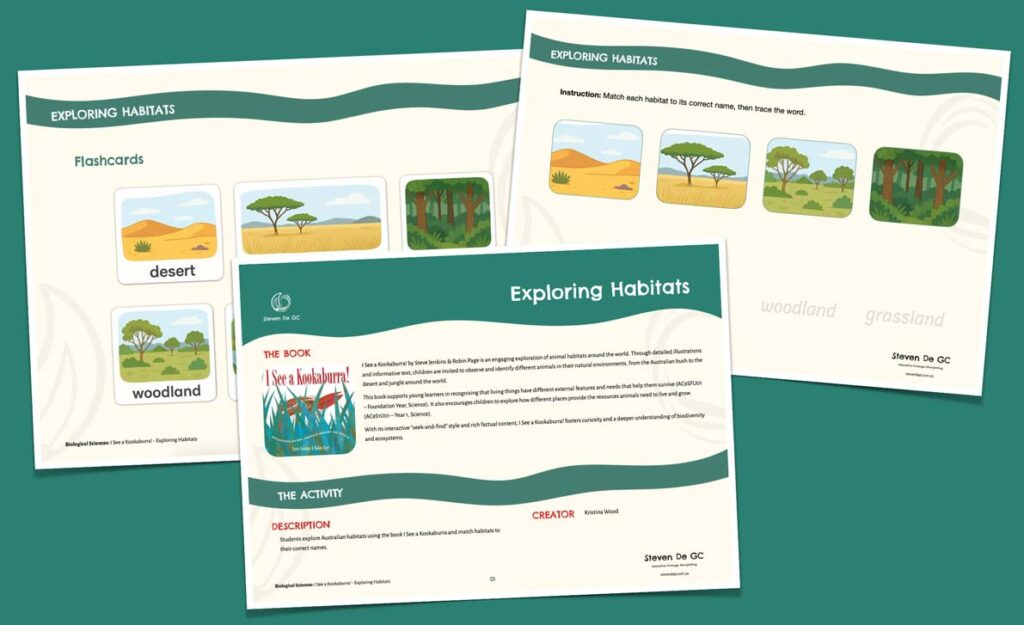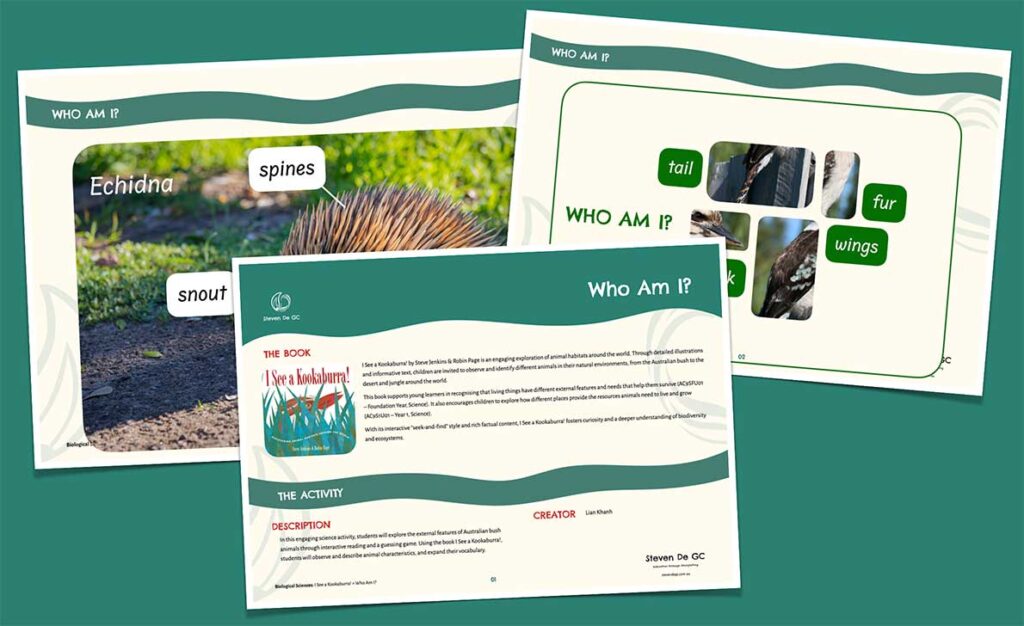Whether in the sky, on the land, or in the sea, animals live in all sorts of fascinating environments. Discover six of the most intriguing habitats, and have fun pinpointing the camouflaged critters hiding within them in this interactive and informative picture book full of furry, feathery, and ferocious creatures. AGES: 4-7 AUTHOR: Steve Jenkins, illustrator of more than thirty children’s books, won a Caldecott Honor for ‘What Do You Do with a Tail Like This?’ Visit his website at www.stevejenkinsbooks.com. Robin Page., with her husband and collaborator, Steve Jenkins, and their three children. Along with writing and illustrating children’s books, Steve and Robin run a graphic design studio.

I See a Kookaburra!
(9780544809734)
Written by Steve Jenkins
Illustrated by Robin Page
Published by Houghton Mifflin Children
Theme/topic: External features and Habitats
I See a Kookaburra! by Steve Jenkins & Robin Page is an engaging exploration of animal habitats around the world. Through detailed illustrations and informative text, children are invited to observe and identify different animals in their natural environments, from the Australian bush to the desert and jungle around the world.
This book supports young learners in recognising that living things have different external features and needs that help them survive (AC9SFU01 – Foundation Year, Science). It also encourages children to explore how different places provide the resources animals need to live and grow (AC9S1U01 – Year 1, Science).
With its interactive “seek-and-find” style and rich factual content, I See a Kookaburra! fosters curiosity and a deeper understanding of biodiversity and ecosystems.
Curriculum Alignment:
- These AC codes are suggested purely based on the book’s content and are provided for reference only.
AC9S1U01 9.0 (Science Year 1): Identify the basic needs of plants and animals, including air, water, food or shelter, and describe how the places they live meet those needs
• identifying the places where plants and animals live, including in our homes, local areas such as ponds, national parks, gardens or zoos
• identifying what they do to look after pets or plants at home and grouping these activities
• identifying and comparing the needs of a variety of plants and animals, including humans, based on their own experiences
• creating dioramas of a place a plant or animal lives, and identifying the features that enable it to meet its needs
• recognising how First Nations Australians care for living things
• exploring why caring for plants and animals is important including as sources of food and fibre
AC9SFU01 9.0 (Science Foundation): Observe external features of plants and animals and describe ways they can be grouped based on these features
• observing fruits and vegetables and identifying them as parts of plants such as roots, flowers, fruits or leaves
• recognising humans as animals, describing external features of humans and exploring similarities and differences compared with other animals
• using magnifying glasses or digital cameras to observe and identify external features of plants including seeds, flowers, fruits and roots, or of animals such as eyes, body covering, legs and wings
• sorting collections of model animals and explaining different grouping strategies
• recognising First Nations Australians’ use of observable features to group living things
• exploring how First Nations Australians’ observations of external features of living things are replicated in traditional dance
Resources
Single Activities
Articles
-

3 Fun Early Years Science Activities about Australian Habitats & Animal Needs
Discover fun Australian habitats and animal needs activities for early years classrooms. Engage kids with hands-on learning and practical science ideas!
-

Engaging Science Activities for Kids: Exploring the World Around Them
Looking for engaging science activities for young children? This collection offers resources for exploring the human body, animal habitats, and the amazing lives of plants.





Leave a Reply